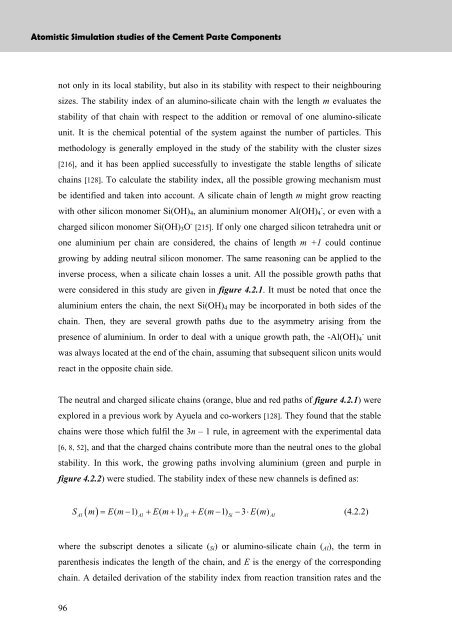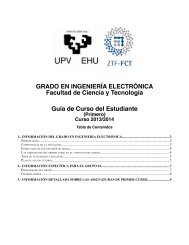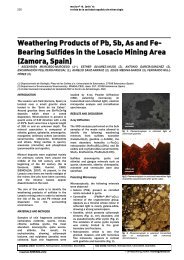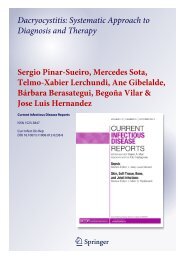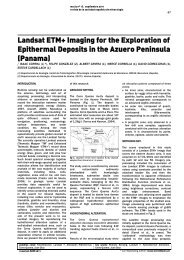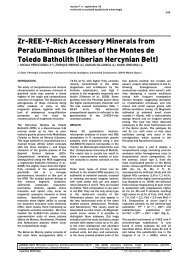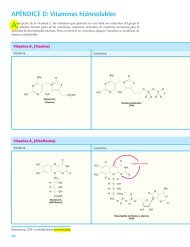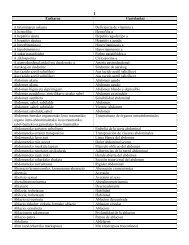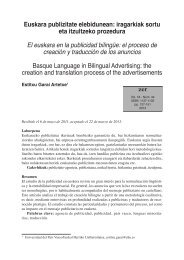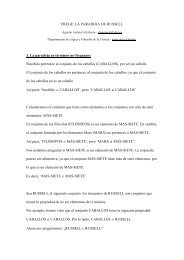Atomistic Simulation studies of the Cement Paste Components
Atomistic Simulation studies of the Cement Paste Components
Atomistic Simulation studies of the Cement Paste Components
You also want an ePaper? Increase the reach of your titles
YUMPU automatically turns print PDFs into web optimized ePapers that Google loves.
<strong>Atomistic</strong> <strong>Simulation</strong> <strong>studies</strong> <strong>of</strong> <strong>the</strong> <strong>Cement</strong> <strong>Paste</strong> <strong>Components</strong><br />
not only in its local stability, but also in its stability with respect to <strong>the</strong>ir neighbouring<br />
sizes. The stability index <strong>of</strong> an alumino-silicate chain with <strong>the</strong> length m evaluates <strong>the</strong><br />
stability <strong>of</strong> that chain with respect to <strong>the</strong> addition or removal <strong>of</strong> one alumino-silicate<br />
unit. It is <strong>the</strong> chemical potential <strong>of</strong> <strong>the</strong> system against <strong>the</strong> number <strong>of</strong> particles. This<br />
methodology is generally employed in <strong>the</strong> study <strong>of</strong> <strong>the</strong> stability with <strong>the</strong> cluster sizes<br />
[216], and it has been applied successfully to investigate <strong>the</strong> stable lengths <strong>of</strong> silicate<br />
chains [128]. To calculate <strong>the</strong> stability index, all <strong>the</strong> possible growing mechanism must<br />
be identified and taken into account. A silicate chain <strong>of</strong> length m might grow reacting<br />
with o<strong>the</strong>r silicon monomer Si(OH) 4 , an aluminium monomer Al(OH) - 4 , or even with a<br />
charged silicon monomer Si(OH) 3 O - [215]. If only one charged silicon tetrahedra unit or<br />
one aluminium per chain are considered, <strong>the</strong> chains <strong>of</strong> length m +1 could continue<br />
growing by adding neutral silicon monomer. The same reasoning can be applied to <strong>the</strong><br />
inverse process, when a silicate chain losses a unit. All <strong>the</strong> possible growth paths that<br />
were considered in this study are given in figure 4.2.1. It must be noted that once <strong>the</strong><br />
aluminium enters <strong>the</strong> chain, <strong>the</strong> next Si(OH) 4 may be incorporated in both sides <strong>of</strong> <strong>the</strong><br />
chain. Then, <strong>the</strong>y are several growth paths due to <strong>the</strong> asymmetry arising from <strong>the</strong><br />
presence <strong>of</strong> aluminium. In order to deal with a unique growth path, <strong>the</strong> -Al(OH) - 4 unit<br />
was always located at <strong>the</strong> end <strong>of</strong> <strong>the</strong> chain, assuming that subsequent silicon units would<br />
react in <strong>the</strong> opposite chain side.<br />
The neutral and charged silicate chains (orange, blue and red paths <strong>of</strong> figure 4.2.1) were<br />
explored in a previous work by Ayuela and co-workers [128]. They found that <strong>the</strong> stable<br />
chains were those which fulfil <strong>the</strong> 3n – 1 rule, in agreement with <strong>the</strong> experimental data<br />
[6, 8, 52], and that <strong>the</strong> charged chains contribute more than <strong>the</strong> neutral ones to <strong>the</strong> global<br />
stability. In this work, <strong>the</strong> growing paths involving aluminium (green and purple in<br />
figure 4.2.2) were studied. The stability index <strong>of</strong> <strong>the</strong>se new channels is defined as:<br />
( ) ( 1) ( 1) ( 1) 3 ( )<br />
S m = Em− + Em+ + Em− − ⋅ Em<br />
(4.2.2)<br />
Al Al Al Si Al<br />
where <strong>the</strong> subscript denotes a silicate ( Si ) or alumino-silicate chain ( Al ), <strong>the</strong> term in<br />
paren<strong>the</strong>sis indicates <strong>the</strong> length <strong>of</strong> <strong>the</strong> chain, and E is <strong>the</strong> energy <strong>of</strong> <strong>the</strong> corresponding<br />
chain. A detailed derivation <strong>of</strong> <strong>the</strong> stability index from reaction transition rates and <strong>the</strong><br />
96


